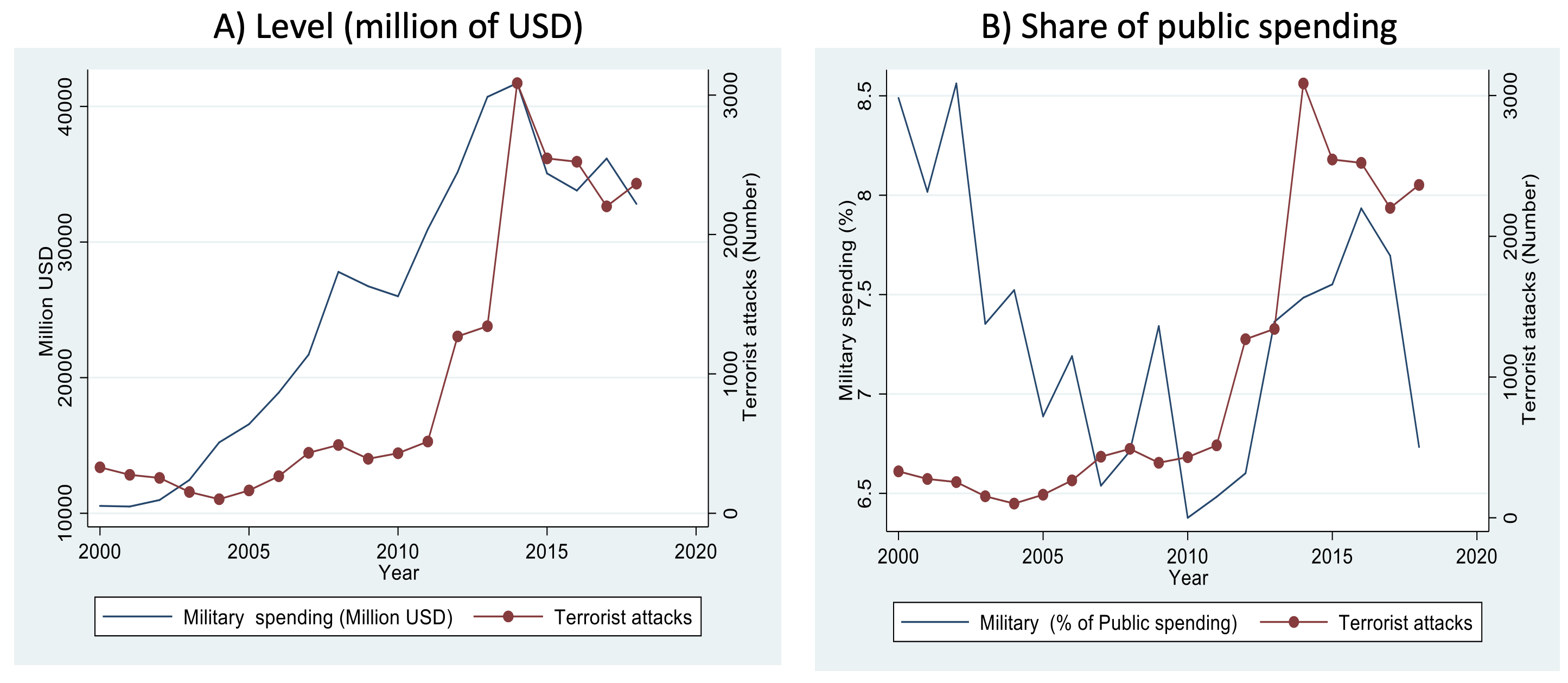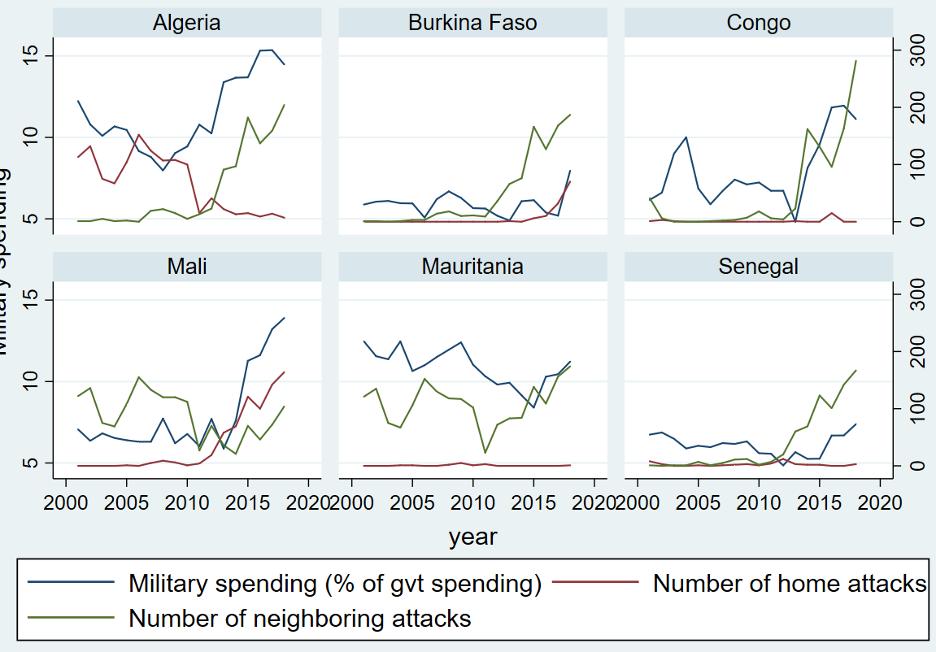Terrorism can have negative effects on economic activities in numerous ways. Most obviously, terrorism results in the destruction of existing human and physical capital, but it also impacts the allocation of individuals’ investment and consumption via increased uncertainty, drawing away resources from productive investments in public infrastructures or human capital. Additionally, it can also serve to drive away foreign resources such as tourism or foreign direct investments (e.g. Frey et al. 2007, Abadie and Gardeazabal 2008).
According to the Global Terrorism Database (GTD), the number of terrorist attacks increased considerably in Africa between 2000 and 2018, rising from 330 attacks in 2000 to 2,365 in 2018. This period also coincided with a significant increase in military spending in Africa, from about $10.6 billion (corresponding to 8.5% of public spending in 2000) to $32.8 billion (or 6.7% of public spending in 2018). Both military spending and terrorist attacks on the continent peaked in 2014 at $41.7 billion and 3,086 attacks, respectively.
As shown panel A of Figure 1, a possible positive correlation exists between military spending (in millions of dollars) and terrorist attacks. Similarly, panel B shows a positive relationship, although weaker, between military spending (as a share of public spending) and terrorist attacks.
Figure 1 Terrorist attacks and military expenditures in Africa, 2000-2018
Source: Authors’ calculations using Global Terrorism Database and World Development Indicators (World Bank).
Fighting terrorism typically suffers from a collective action problem
There are two main categories of antiterrorism policies: offensive and defensive. Offensive (or proactive) measures target the terrorists, their resources, or their supporters directly, including attacking terrorist groups or camps, freezing terrorist assets, or retaliating against a state-sponsor.
Defensive (or passive) measures try to reduce the vulnerability of individuals and property to attacks, for instance through technological barriers such as bomb-sniffing devices, metal detectors, or biometric identification, or the deployment and equipment of security personnel.
The fight against international terrorism typically exhibits a collective action failure problem. Pre-emptive measures can be seen as international public goods, with non-targeted countries taking the opportunity to free ride on the efforts of others. On the other hand, defensive measures are largely seen as private goods because the benefits go primarily to the country implementing those measures (Sandler 2005).
As a result, non-targeted countries tend to place the burden of offensive counterterrorism measures solely on countries that are the target of terrorist attacks, thereby benefitting from the reduction of terrorism without paying for it.
Collective action failure overlooks spillover effects
This collective action failure typically overlooks the spillover effects of terrorist attacks. In a recent paper (Boly and Kere 2023), we use spatial econometric techniques on a sample of 34 African countries to show that the occurrence of terrorist attacks has both domestic and cross-border positive effects on military expenditure as a share of general government spending. An increase in terrorism does not only lead to an increase in military spending in the attacked country, but also in neighbouring countries, as shown in Figure 2. For instance, in Burkina Faso and Mali, military spending increased with both the number of terrorist attacks at home and in neighbouring countries. Likewise, even in Algeria, Congo, Mauritania, and Senegal, where the number of terrorist attacks at home remains stable and low (or in the case of Algeria, even decreasing), we see that military spending increases with the number of terrorist attacks in neighbouring countries.
The reaction of the attacked country is consistent with reactive counterterrorism measures to deter future terrorist attacks, while the increase in bordering countries is consistent with preventive counterterrorism measures.
Figure 2 Military expenses and home and neighbours’ terrorist attacks
Source: Authors’ calculations using Global Terrorism Database and World Development Indicators (World Bank).
Why does military spending increase?
Our results also suggest the presence of military spending complementarity, whereby increased military spending in neighbouring countries has a positive impact on military spending in the home country. Complementarity in military spending can be explained through ‘yardstick’ competition between countries. In a world where citizens do not have precise information on the performance of incumbent public officials, yardstick competition assumes that citizens or organised groups compare their area – which could be a city, region, or country – to others when assessing the performance of incumbent officials (e.g. Salmon 1987, Besley and Case 1995). Incumbent officials take this comparison into account and seek to mimic policy decisions in neighbouring jurisdictions in order to increase their chances of keeping office.
Arguably, in an environment with rising terrorism and access to information about attacks, to increase their chances of staying in power incumbent politicians will look at the level of military spending in neighbouring countries and seek to emulate it, to provide or maintain an acceptable security level in the home country.
Alternatively, yardstick competition may be due to the anticipation that a tougher stance against terrorism in neighbouring countries, through higher military spending, could push terrorism towards the home country, hence the need to increase military home spending. Such an increase would be fundamentally motivated by the desire to provide an acceptable security level in the home country and thus keep power.
The implications of higher military spending
The effects of increased military spending on growth are likely to be negative for developing countries by diverting resources from crucial productive investments, given that higher military spending usually entails higher imports of military equipment (Collier 2006).
As a result, both terrorism and government mimicking behaviour, through their positive effects on military expenditure, can negatively impact a country’s growth. Importantly, these negative effects can materialise even without direct terrorist attacks in a country due to the presence of spillover effects.
Greater collaboration is urgently needed to win the fight
The spillover effects point to the urgent need for collective action to address security challenges, particularly terrorism, in Africa. This can be done at the bilateral, regional, continental, and global levels.
Neighbouring countries could consider actively supporting affected countries to fight terrorism before directly suffering its consequences. An illustration of this bilateral approach is the deployment of Rwanda Defence Force in 2021 in the Cabo Delgado province of northern Mozambique to fight terrorism, then followed by the deployment of the Southern African Development Community (SADC) Standby Force.
Regional security mechanisms are much needed. In West Africa and the Sahel, such mechanisms include the G5 Sahel Joint Force (FC-G5S), the Multinational Joint Task Force (MNJTF) fighting Boko Haram-affiliated groups, the Accra Initiative, and the Economic Community of West African States (ECOWAS) Standby Force. However, given the multiplicity and overlapping memberships of regional communities or mechanisms, rationalisation and consolidation should be prioritised to eradicate resource wastage due to costly duplication, fragmentation, or lack of coordination of activities. Effective participation by neighbouring countries, not currently facing terrorist attacks, should also be sought.
At the continental level, accelerated revitalisation and operationalisation of the African Peace and Security Architecture (APSA) is needed, including expedited and pragmatic implementation of the 0.2% levy on eligible imports to increase the African Union’s financial autonomy. This would help ensure that the Union is successful in its pursuit of “African solutions to African problems”, in collaboration with the Regional Economic Communities, Regional Mechanisms, and the International Community.
Collective action is also needed to support national efforts aimed at tackling terrorism-supporting activities such as organised crime networks, which can help finance terrorism by engaging in money-laundering, cybercrime, or trafficking in people, drugs, weapons, and cultural objects. By curbing financial support to terrorism, international cooperation can weaken the ability of terrorists to operate and reduce the frequency and prevalence of terrorist attacks.
Finally, African countries must address the root causes of terrorism in the longer term by committing to socioeconomic progress and shared prosperity for all citizens. This will include embracing bold governance reforms, aimed at strengthening public financial management, promoting transparency and accountability in public service delivery, and fighting corruption.
Authors’ note: The views expressed here are those of the authors and do not necessarily reflect the views of the African Development Bank Group. The Bank Group does not guarantee the accuracy of data used.
References
Abadie, A and J Gardeazabal (2008), “Terrorism and the World Economy”, European Economic Review 52(1): 1-27.
Besley, T and A Case (1995), “Incumbent Behavior: Vote-Seeking, Tax-Setting, and Yardstick Competition”, American Economic Review 85: 25–45.
Boly, A and E N Kere (2023), “Terrorism and Military Expenditure in Africa: An Analysis of Spillover Effects”, Working Paper N° 368, African Development Bank, Abidjan, Côte d’Ivoire.
Collier, P (2006), “War and Military Expenditure in Developing Countries and Their Consequences for Development”, Economics of Peace and Security Journal 1(1): 9–13.
Frey, B S, S Luechingerand A Stutzer (2007), “Calculating Tragedy: Assessing the Costs of Terrorism”, Journal of Economic Surveys 21(1): 1-24.
Salmon, P (1987), “Decentralisation as an incentive scheme”, Oxford Review of Economic Policy 3(2): 24-43.
Sandler, T (2005), “Collective versus Unilateral Responses to Terrorism”, Public Choice 124(1/2): 75–93.





